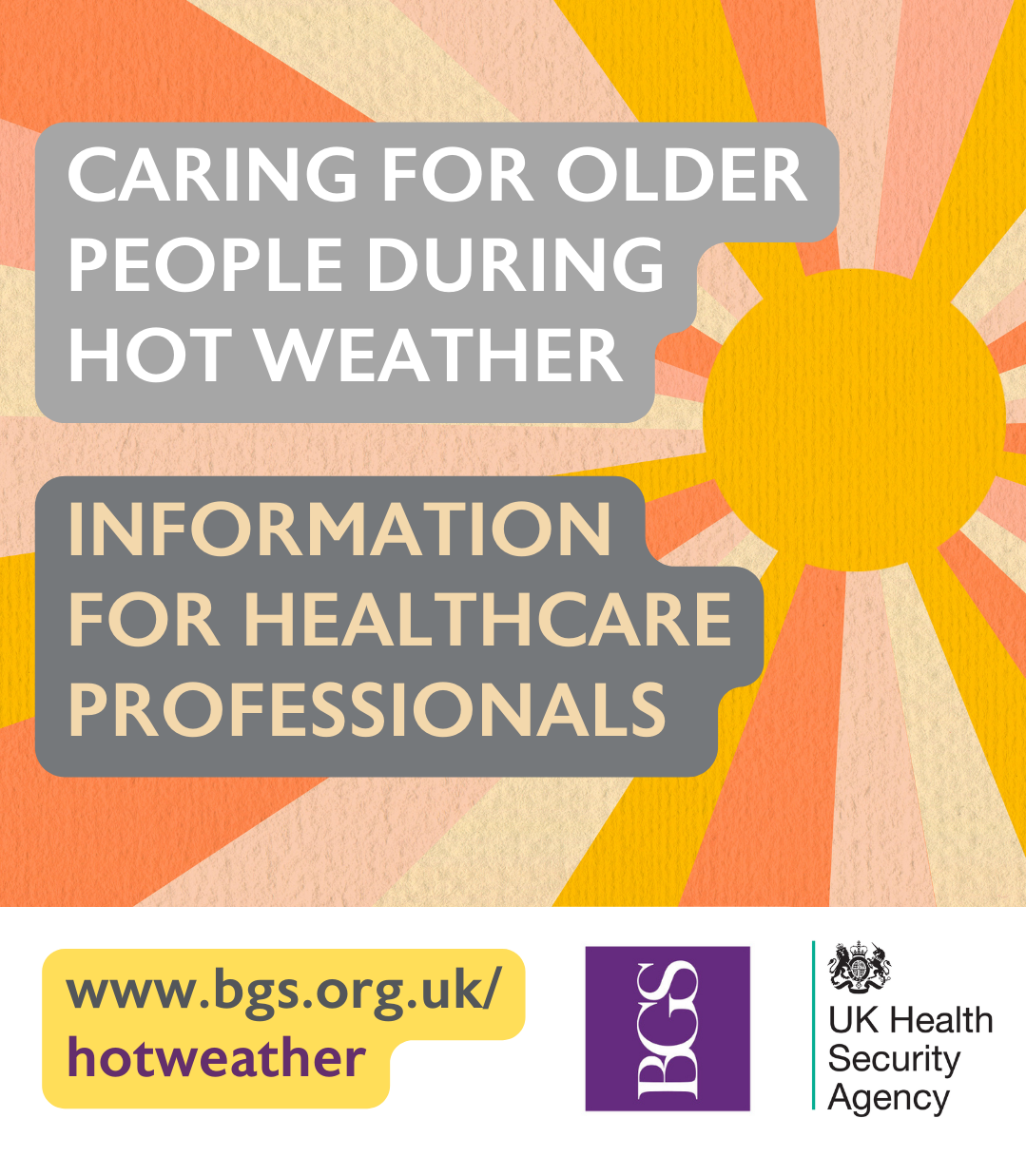Information for healthcare professionals caring for older people during hot weather
This article lays out UK Health Security Agency’s guidance on how healthcare professionals can best prepare for hot weather and how to look after older adults in extreme heat.
Climate change is already causing warmer temperatures in the UK and in July 2022 temperatures exceeded 40°C for the first time on record. A total 2,803 people aged over 65 died due to the heat in England in 2022, and it is predicted that the number of heat-related deaths per year may triple by 2050.
In order to protect individuals and communities from the health effects of the increasing number of adverse weather events and build community resilience, the UK Health Security Agency (UKHSA) published the Adverse Weather and Health Plan.
The plan outlines the areas where public sector, independent sector, voluntary sector, health and social care organisations and local communities can work together to maintain and improve arrangements for planning and response to deliver the best health outcomes possible during adverse weather.
Weather-Health Alerting System
To support the Plan, the Weather-Health Alerting System was launched by the UKHSA in partnership with the Met Office. The Weather-Health Alerting System is made up of the Heat-Health Alerts (HHA) and Cold-Health Alerts (CHA). The core alerting season for the HHA runs from 1 June to 30 September, with the core alerting season for CHA running from 1 November to 31 March.
The alerts began in June with HHAs. The alerts provide the health and social care sector, responder community, voluntary and community sector and government departments an early warning when adverse temperatures are likely to impact on the health and wellbeing of the population.
UKHSA has been encouraging stakeholders, including healthcare professionals, to sign up to the alerts so they are aware of the risk to their vulnerable and/or older patients and the potential impact on the health system, and can therefore prepare and respond appropriately.
Guidance
As part of the Plan, guidance was developed on how to support vulnerable people, including those over the age of 65, in hot weather.
This article will lay out UKSHA’s guidance on how healthcare professionals can best prepare for hot weather and how to look after patients in extreme heat.
Supporting vulnerable people before and during hot weather: healthcare professionals
The below is a summarised version of the guidance for healthcare professionals working in community, care home or hospital environments. Please continue to refer to this link as the guidance will be routinely updated.
You can reduce the risks associated with hot weather for those you care for by:
1. Adapting individual care plans to respond to hot weather
Make as much use as possible of existing care plans to assess which individuals are at particular risk, and to identify what extra help they might need. Where possible, involve their family and any informal carers in these arrangements.
Anyone in a high-risk category who is living alone is likely to need at least daily contact, whether by care workers, volunteers, or informal carers. Individuals at greater risk may need extra care and support.
Check that:
- Extra care and support are available if needed.
- The person can contact the primary care team if one of their informal carers is unavailable.
- Their care plan contains contact details for their GP, other care workers and informal carers.
- There are adequate arrangements for food shopping and other essentials, to reduce having to go out in hot weather.
2. Having action plans in place for your organisation and/or place of work tailored to the local context
Preparation before hot weather is forecast is essential and plans should be agreed and communicated appropriately before 1 June each year.
UKHSA have produced Heat-Health Alert (HHA) action cards which summarise suggested actions to be taken by different professional bodies and organisations in the event of extreme heat. You may wish to consider using these when writing your action plan.
3. Knowing who is at risk
In moderate hot weather, it is mainly individuals in the high-risk groups that are affected.
Consider:
- What the individual(s) risk factors are for being ill during hot weather.
- What can be changed to protect them.
An individual’s risk is related to a combination of factors relating to their health, behaviours and environment. High-risk factors include:
- Older age, especially those over 65 years old (note change from previous guidance of 75 years of age and above).
- Children under 5 years of age.
- Those living on their own, and who may be unable to care for themselves or are socially isolated.
- Individuals that depend on others for routine activities.
- Medical conditions including cardiovascular, kidney and respiratory conditions, diabetes, peripheral vascular disease, Parkinson’s disease, obesity, or severe mental illness.
- Medications that potentially affect heart or kidney function or an individual’s behaviour, cognition or ability to sweat.
- Behavioural limitations - for example cognitive impairment (such as dementia), restricted mobility, or the use of alcohol or other recreational drugs.
- Overexposure to heat - for example, living in a top floor flat, being homeless, or outdoor occupations and activities.
4. Knowing how to treat heat-related illnesses
There is a spectrum of heat-related illnesses ranging from heat cramps, through heat exhaustion, to heatstroke. These are avoidable and preventable by early intervention and preparation.
Heat cramps
Symptoms of heat cramps include:
- Painful muscular spasms caused by electrolyte imbalance, often following exercise.
- Intense thirst with muscle cramps and a high heart rate.
- Sweating preserved.
- Normal cognitive state.
Heat exhaustion
Symptoms of heat exhaustion include:
- Body temperature rising but still capable of dissipating heat.
- Appearing flushed and sweaty and complaining of feeling hot.
- Mild cognitive dysfunction with mild confusion, irritability, and anxiety; poor coordination may occur.
- Other signs of organ dysfunction may be present, including decreased urine output, headache, thirst, fainting, orthostatic hypotension and nausea.
Heatstroke
Heatstroke is a medical emergency and needs urgent management in hospital.
Heatstroke can be classic, due to passive exposure to extreme heat, or exertional from strenuous physical exercise.
In both cases, the body loses the capacity to dissipate heat and there is central nervous system impairment. Heatstroke commonly presents with hyperventilation, hypotension and shock. The thermoregulatory centre may fail, so affected individuals may feel cold and dry to touch.
The loss of ability to sweat is a late and severe sign of heatstroke. Multiple organ dysfunction and death can rapidly occur.
The WHO guidelines contain more details and clinical management.
Emergency treatment of heatstroke
If you are outside a hospital setting and you suspect someone has heatstroke, call 999.
While waiting for the ambulance:
- Take the person’s temperature.
- If possible, move them somewhere cooler.
- Cool them down as quickly as possible by spraying with cool water, and using a fan to maintain an air current if ambient temperature below 35°C.
- Place cold packs on neck, armpits, and groin.
- Encourage them to drink cool fluids if they are conscious.
- Do not give aspirin or paracetamol.
5. Being alert to increased cardiovascular and respiratory complications
During severe hot weather, there is a risk of developing heat exhaustion, heatstroke and other heat-related illnesses including respiratory and heart problems.
However, the main causes of illness and death from hot weather are respiratory and cardiovascular diseases. Part of this rise may be attributable to air pollution, which can worsen in hot weather. So those with pre-existing lung or cardiovascular conditions should take extra care.
Hot weather and dehydration increase the risk of infection and sepsis caused by Gram-negative bacteria, particularly Escherichia coli. The risk is greatest in individuals aged over 65, emphasising the importance of ensuring adequate fluid intake in older people.
6. Considering medications that increase risk to heat
Some medications increase the risk of adverse health outcomes during hot weather. The degree of risk depends on the person’s lifestyle, health status as well as their medications.
The medications listed below are non-exhaustive and serve as a prompt to consider action and assess the risks and benefits of any changes:
- Diuretics, especially loop diuretics, can lead to dehydration and electrolyte abnormalities.
- Medications that interfere with cardiovascular responses such as antihypertensives and antianginal drugs.
- Medications that interfere with sweating, such as anticholinergics or beta blockers.
- Drugs that cause diarrhoea or vomiting, such as colchicine, antibiotics and opiates, which can lead to dehydration.
- Medications that can impair renal function, such as certain antimicrobials, immunosuppressants, non-steroidal anti-inflammatories, anti-ulcer agents and chemotherapies.
- Agents with levels affected by dehydration, such as lithium, digoxin, antiepileptics.
- Drugs that alter states of alertness, such as hypnotics, anxiolytics and analgesics.
- Medications that can interfere with central nervous system thermoregulation, such as neuroleptics and serotoninergic agonists.
- Drugs that increase basal metabolic rate such as thyroxine.
Storage of medications
Most medicines should be kept below 25°C, so they should be stored somewhere cool, dry, out of direct sunlight and away from windowsills. Medicines should only be stored in the fridge if specified. The NHS Specialist Pharmacy Service has further guidance.
7. Promoting environmental and behavioural changes that could reduce the risk of hot weather
Buildings and resources can be kept cool by:
- Turning off non-essential appliances and heating systems to reduce indoor heat production.
- Externally shading south facing windows with shutters, awnings, or the placement of plants.
- Internally shading south facing windows with pale, reflective curtains or blinds (avoid metal blinds or curtains with dark linings, as these absorb heat).
- Closing windows when it is hotter outside than inside and opening windows when it is cooler outside (for example at night) if safe to do so.
- Keeping the windows closed if air conditioning is used – this will keep the cooler air inside.
- Checking that fridges and freezers work properly and have sufficient capacity to supply enough cool water and unspoilt food.
- Using fans if ambient temperature is below 35°C – if temperatures are higher than this, fans can raise body temperatures.
- Planting trees and shrubs to provide shade and cool the air around the building; indoor plants may help keep the indoors cool.
Further advice for buildings can be found on GOV.UK.
As well as keeping indoor temperatures as cool as possible, consider the following to reduce individuals’ risk:
- Move the most vulnerable to the coolest rooms (a cool room should ideally be less than 26°C).
- Reduce physical exertion, for example reschedule physiotherapy to cooler times of the day.
- Promote regular cool showers, baths or body washes.
- Advise wearing light, loose-fitting clothes that absorbs sweat and prevent skin irritation.
- Minimise sun exposure between the hours of 11am and 3pm.
- Promote sunscreen use.
- Sprinkle clothes with water regularly and splash cool water on their face and the back of their neck.
- Serve cold food, particularly salads, fruit and ice lollies which have a high water content.
- Promote regular drinking, preferably water or fruit juice, and advise against alcohol use.
- Monitor fluid intake, which can be done by monitoring body weight.
Further information
The above guidance is for healthcare professionals. Separate guidance for social care managers, staff and carers can be found on the UKHSA website.

